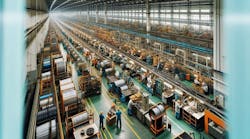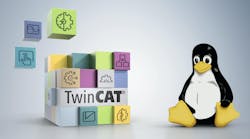The Difference Between Soft Starters and Variable Frequency Drives
Read the full transcript below
David Greenfield: Welcome to the Automation World Gets Your Questions Answered podcast, where we connect with industry experts to get the answers you need about industrial automation technologies. And you can find even more answers by subscribing to automation world at Subscribe AutomationWorld.com
I'm David Greenfield, Director of Content for Automation World. The question we’ll be answering in this episode is: How do soft starters and variable frequency drives compare? Joining me to answer this question is Jacob Becker, system solution architect at system integrator Tri Tech Automation. So, thanks for joining me today Jacob.
Jacob Becker: Thanks for having me David.
David Greenfield: So you know Jacob, I've often heard that the decision to use a low- voltage soft starter or a variable frequency drive depends of course on the application. But before we get into that discussion I'd like to take just a moment to look at the two technologies themselves to make sure that all of our listeners are on the same page. So let's start with soft starters. What are they essentially and what do they do.
Jacob Becker: Sure. So a soft starter is simply a motor control device that allows as the name would imply an electric motor to be started up slowly or softly it uses SCRs which are basically solid State Relays back to back. Um, and it reduces the voltage to the motor and thus it reduces the current to the motor which will allow the motor to start up slowly and in a controlled fashion. The time that the slowness of start takes place is configurable as is the reduction in the voltage. But this allows the motor to start up slowly and gently and reduce stress on to some mechanical pieces.
David Greenfield: Now let's do the same for VFDs. I think most people are aware that you know their main use is to control motor speeds. But can you describe in a bit more detail what they are and what they're used for.
Jacob Becker: Sure so ah, a variable frequency drive is a bit more a complex motor control device. So like the soft starter it does start and stop motors. But as you mentioned the VFD allows the motor to be controlled at speed to be controlled continuously. So a VFD actually takes the incoming AC power rectifies it to a DC voltage then uses IGBTs to take that DC voltage and invert it into a square wave waveform that simulates an alternating current. With that simulated waveform we can modify the frequency of the waveform and thus change the speed of the motor.
David Greenfield: And just before moving on and and then we can talk about this later too. But you mentioned IGBTs can you give just a ah quick explanation about what those are.
Jacob Becker: Sure IGBTs are transistors so they're switches that fire very quickly and that's what allows us to get that waveform by turning them off and on very quickly we can generate a square wave.
David Greenfield: Thanks for clarifying that. So there seems to be you know three big differences when you look at comparing soft starters and VFDs you know the first of which courses cost was soft starters being the cheaper option. Then there's the ability to control motor speed which VFDs offer but soft soft starters lack and then there's performance parameters and tuning capabilities both of which have more options on VFDs than soft starters. But beyond those main factors are there other key differences that users should be aware of when deciding between the two.
Jacob Becker: Sure. The first would be complexity. A VFD is a considerably more complex piece of equipment than what a soft starter is it has a lot more active components—IGBTs, capacitors, rectifiers, things of that nature. Um, since you know it has more active components like you mentioned there is additional cost. Um, there also is a size difference for a light for like motor size. A VFD is typically going to be fairly bigger than a than a soft starter. We all know that plant floor. Space is at a premium. So if you don't need a VFD a soft starter might be a great way to save some space and additionally some some cost the next difference is heat like I mentioned there's a lot more active components in a VFD a VFD of equal size to a soft starter will put out considerably more heat than. Then a soft starter will because the components as we'll talk about later are always active on a VFD. So a lot of the a lot of the components that we need to worry about are around the installation of VFD so the size the heat additionally is cabling so with a VFD since we chop up that wave forming. Create that simulated square wave out on the out on the line. You can get a reflected wave back on the cabling so oftentimes a special cabling and then ah a line reactor is also recommended for long runs to prevent harmonics from being passed back onto the onto the power source. So if you have a lot of VFDs with long runs you run the risk of getting harmonic distortion on your on your power source and that can affect other equipment in the plant, especially sensitive equipment like instrumentation or PLCs.
David Greenfield: And I imagine would that also have an impact on the type of enclosure that you choose based on that as well.
Jacob Becker: Absolutely its going to make your enclosure a lot bigger and then it's going to come back to space and yeah VFDs take up quite a bit more space.
David Greenfield: With more manufacturers looking to make their operations more sustainable and reduce energy costs, overall efficiency would be an important consideration when making this is the decision between a soft starter or a VFD. I mean on the one hand you have the ability with a VFD to control motor speeds which can have a significant impact on efficiencies and costs. But soft starters also help reduce motor energy use and looking at the overall operation of the two devices soft starters often edge out the VFDs in terms of operating efficiency though just by a couple of percentage points. So considering all these issues, which one is likely to be the more efficient energy choice overall.
Jacob Becker: Sure That's ah, that's a great question and like a lot of questions and in engineering, it kind of depends — it all comes down to an application standpoint if you have a motor that you know you're going to start up and you want to start it up in a controlled fashion but it is going to run at a fixed speed all the time. The soft starter is the clear answer simply due to the fact that a lot of soft starters have bypass contactors either inside them or they will be added externally so that means once the motor is up to Speed. We shut off the we will energize the bypass contactor and then the soft starter. Components will actually shut down and not use any power. So There's no efficiency loss. There. The only time they're active is during the startup and potentially depending on application. The shutdown of that motor now a VFD would be more efficient in an instance where you might be able to start up a motor and run it at full speed for a period of time. But during a low load application. You still need to run it but you can reduce the speed of that motor say for a fan or a pump during a low-load application but you still need those devices to run you could slow them down and that would be a more energy efficient standpoint. But if you need to start it up and run it at full speed—60 hertz—all the time, the VFD will be constantly active, the IGBTs, the filters, everything is active and that that draws some power and will make them slightly less efficient though. They're both—Both devices are extremely efficient as far as as equipment goes.
David Greenfield: With just as couple of percentage points difference really between them, as we alluded to earlier in the discussion, it really depends on the application—what you're doing with the motor is the biggest factor when it comes to efficiency anyway.
Jacob Becker: Absolutely.
David Greenfield: So comparing the two technologies side-by-side, how do they stack up in your opinion and by that I mean you know what types of applications would a soft starter make more sense for and for what kinds of applications would a VFD make more sense for.
Jacob Becker: Sure So as I alluded to in the previous question. The soft starter really makes the most sense whenever you have kind of a constant load and a a constant speed application that still needs a gentle start or a gentle stop. This might be a fan or a pump could be conveyor belts. Soft starters are great for conveyor belts where if you need to start a belt but you don't want things on the belt to fall over, soft start would be a great thing. You could slowly ramp that motor up and then run it at full speed and then slowly ramp it back down. I've seen a lot of soft starters on screw compressors for refrigeration to keep from banging the screws on. It slowly ramps the screws up. Same thing for pumps you could use a solve start for a pump that is going to run at full speed all the time but you want to a mitigate water hammer, for example. Now VFDs on the other hand are almost infinitely flexible. Um, flexible tunable. Ah, they offer more precise control like I said they're a much more complex piece of equipment than a soft starter so in my opinion VFDs kind of eke out soft starters on almost all applications up until you get to a certain motor size. There's kind of a break point where it just makes more sense to put a VFD in. So any kind of a pumping application where you want to modulate flow but you don't want to put a control valve in, Then for example, that's a great spot for a VFD We do that all the time you may want to put a fan in and modulate the fan speed for cooling but you don't want to add a damper to reduce your flow rates at certain times, then a VFD is a great application. Also on smaller conveyor belts where you need to modulate the speed on, say, a packaging line so you can handle accumulation or equipment shutdowns. You may want to slow those down. But really most of the time VFDs can work just about anywhere a soft starter would work. They're can be quite a bit more expensive when you get to a larger size motor. But for like a 50 horsepower motor and below. We Typically recommend our customers just go with a VFD instead of a soft starter — that way they have that flexibility should they want it—built in and it's already there for them to use.
David Greenfield: And I guess the cost difference that you reference there—that pays back for itself over a certain amount of time depending on usage to make it worth that initial upfront cost?
Jacob Becker: Generally speaking yes and like I mentioned before, a lot of the a lot of the considerations that you have to take into account such as the cabling, the filtering, the heat, the enclosure size on smaller motors—like I said 50 horsepower or less. That's not quite as big of a deal. The cost isn't quite as drastic there. The the cost differential— both the the equipment purchase and the installation cost—gets wider as the motors get bigger. Um, but for a lot of customers where a lot of our our end users are. The VFD brings a lot more flexibility that they may not have with a soft starter and that's the ultimate difference in my opinion between VFDs and soft starters is the flexibility that you get just out of the box with a VFD.
David Greenfield: With all the parameter options and everything else that come with it, with a soft starter its basically off or on.
Jacob Becker: Yeah, exactly, that's the case with a soft starter. It's off or on — you can do reversing with them. It's a little bit more complex than doing reversing with a VFD. But the off starter a lot of times you have to have reversing contactors which adds cabling cost um tabling cost installation cost more maintenance.
David Greenfield: Thank you for all of these insights in this discussion but we've just really hit on this topic at a very high level I mean there's a lot more granularity that you can get into with both of these technologies. So without getting too far down in the details, but before we sign off, are there any other points that you'd like to add about choosing between a soft starter and a VFD that we haven't covered here today that our listeners should be aware of.
Jacob Becker: Yeah, one thing that we haven't really touched on is and across the line starter, which simply takes line voltage—Let's say 480 volts—closes a contactor and sends full 480 volts to the motor so that starts the motor up gives it full inrush current. It gives it maximum torque—everything that the motor wants and starts it up as quick as possible. For some applications This is perfectly fine, for others where you may want like I said for soft starters where you may want things to start up easily. You may want it to start up gently to protect equipment to reduce current inrush that may not be the best application and that's where a soft starter would work best or if you need to control the speed. That's where a VFD would step in.
David Greenfield: Well thank you again for joining me for this podcast Jacob and thanks of course to all of our listeners, please keep watching this space for more installments of Automation World Gets Your Questions Answered. And remember that you can find us online at AutomationWorld.com. And subscribe to our print magazine at SubscribeAW.com to stay on top of the latest industrial automation technology insights, trends, and news.
Companies in this Article

Leaders relevant to this content:



